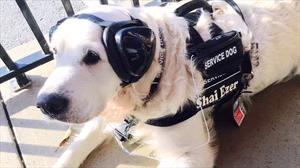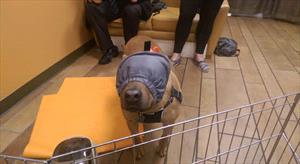Storm phobia, or fear of storms, is a common behavior in dogs. Many dogs are terrified of the noise and react by hiding, pacing, panting, trembling, peeing, pooping, drooling, and destroying things. Some dogs even take it to the extreme of hurting themselves by jumping through windows and doors. These behaviors can appear during a storm, or when they see or hear things such as thunder, lightning, rain, or formation of dark storm clouds.
Another type of noise phobia is the fear of fireworks and gunshots. Dogs with this fear show similar behaviors to storm phobic dogs. Some become so fearful they do not want to go outside the house or around the area they associate with these noises.
Treating Storm and Noise Phobia
Environmental Management
The first step in managing and treating all types of noise phobia in dogs is to give them a safe place to hide. This safe haven can be a windowless basement, closet, crate, or bathroom. It is important to make sure your dog has access to this area when no one is home.
Mutt Muffs

Photo courtesy of Patty Aguirre.
The noise of a radio, television, white noise machine, fan, or air conditioner reduces how much they hear of rain, thunder, and other scary noises.
Classical music can be relaxing for some dogs. Anxiety wraps or close-fitting t-shirts may help calm your dog. Other useful devices are dog earmuffs to reduce noise sensitivity, and calming caps to decrease ability to see the storm.
Pheromones may be beneficial in some cases. These come in a diffuser, wipes, or spray. These pheromones can be placed on a bandanna, blanket, or a favorite toy to reduce anxiety.
Thundercap

Photo courtesy of Christine Calder, DVM, DACVB.
Behavior Modification
Comforting: When it comes to the benefits of comforting your dog, the jury is still out. Many dogs enjoy the comfort of your closeness and reassurance whereas others become more anxious. Monitor your dog. If they become more fearful, stop trying to comfort them. If attention and touch calm your dog, there is no reason to stop.
Desensitization and counterconditioning are forms of behavior modification used to reduce the fear of noise and storms. Desensitization exposes the dog to a scary noise at such a low level that the animal is not scared. Counterconditioning changes the association of the noise with fear. Try to play with your dog, or do fun tricks he knows to distract your dog.
Food can also be a distraction, like an extra special treat that only comes out during scary events. Food puzzles (similar to these shown for cats) allow your dog to anticipate something fun and special when a storm is roaring overhead.
Short-Acting Medications
There are medications your veterinarian can prescribe to reduce the fear in your dog.
If medications are used, they must be given before the scary noise to be effective. Watch the weather closely and administer medication before the storm is predicted to arrive. It is better to medicate and no storm, than no medication and a storm. The same is true for other noise events.
Behavioral supplements may be beneficial in some dogs.
A magic pill to treat a noise or storm phobia does not exist. Treatment involves a combination of environmental management, behavior modification, and medication. Fear of noises can be reduced, but a cure is rare.